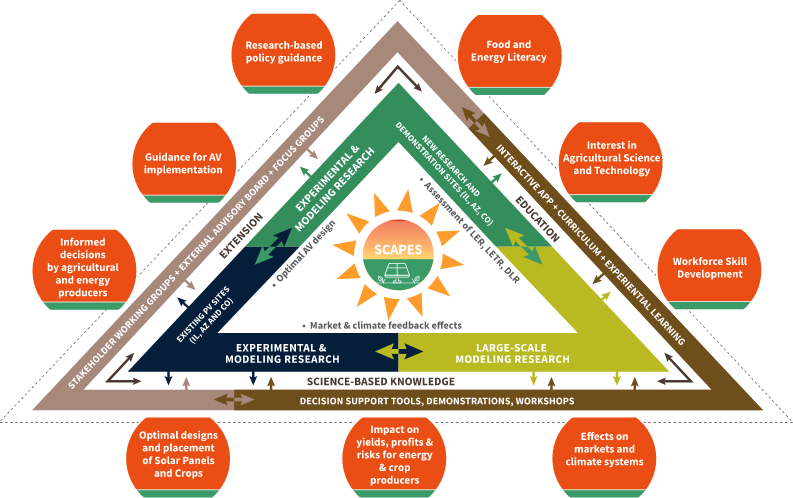Sustainably Co-locating Agricultural and Photovoltaic Electricity Systems

The SCAPES project aims to blend agriculture and solar power (AV technologies) in a way that boosts U.S. farmers’ resilience and income while maintaining food production and ramping up renewable energy. It aligns with USDA goals for sustainable farming and climate adaptation. The project will stimulate rural economies and ensure long-term sustainability of farming and renewable energy.
Solar technology is becoming more affordable and desirable, tempting landowners to consider switching from farming to solar production. However, this transition could lead to a decline in crop production and potentially compromise food security. This is where agrivoltaics comes into play, a novel approach that merges solar power and agriculture.
How the system works
Ideally, ground-level solar panels are positioned to allow enough sunlight for the crops, which grow underneath. The panels help keep the soil moist, along with keeping the crops cool during the day and warm at night. In turn, the plants help the panels in transferring water from the soul into the atmosphere. The plants keep the panels cool–and efficient–during the day, producing more energy

Agrivoltaics boosts land use, productivity, and farm profitability, while reducing water consumption. This system increases energy output by leveraging cooler temperatures under solar panels, improves certain crop yields via shading, and enhances water efficiency, offering a sustainable approach for the agriculture and energy sectors. While it is gaining traction in Asia and Europe, interest in agrivoltaics is also on the rise in the U.S. However, comprehensive research in this field has been scarce thus far. The aim of the SCAPES project is to deepen understanding of agrivoltaics for varied crops in three different U.S. regions: Illinois, Colorado, and Arizona. The team will conduct field tests, assess the financial implications, survey farmers, and simulate the potential outcomes for the entire country. In addition, they will evaluate the effects on the market and climate.
The SCAPES team is committed to active engagement with stakeholders to share knowledge, guide their research, and inspire future leaders about the potential of agrivoltaics as a sustainable solution for food and energy.
Project Overview:
- Establish C3 and C4 crop species between solar panels in each region’s existing solar farms. Observe their reactions to varying levels, durations, and timings of shade.
- Use the data from these experiments to create a crop-solar panel simulation models to inform the public and run a national scale economic-ecosystem modeling.
- Utilize three existing solar farms (Solar Farm 2.0 at UI, Jack’s Solar Garden at CSU, and the Agrivoltaics Learning Lab at UA) to study microclimatic and plant responses to solar panels.
Agrivoltaics’ impact
As agrivoltaics innovators, SCAPES project researchers experience its impact first-hand. Agrivoltaics helps energy generation and crop production. It can help harmers profit. It provides new opportunities for the energy industry. It can guide the U.S. policy. And it presents new fields of study and bright career paths for the next generation.

Champaign, Illinois specific information:
- Crops grown include: C3 (soybean and clover) and C4 (sorghum)
- Site locations: Solar Farm 2.0 (https://icap.sustainability.illinois.edu/node/4013), Vegetable Crops Research Farm, and the Energy Farm (https://energyfarm.illinois.edu/)
- The first year of crop production took place in the Spring of 2023
- Challenges: lack of rainfall has hampered crop growth, seedling predation within solar panels has been significant
SCAPES Project Members

Jinwook (JK) Kim
Postdoctoral Research Associate
Former SCAPES Project Members

Gevan Behnke
Postdoctoral Research Associate